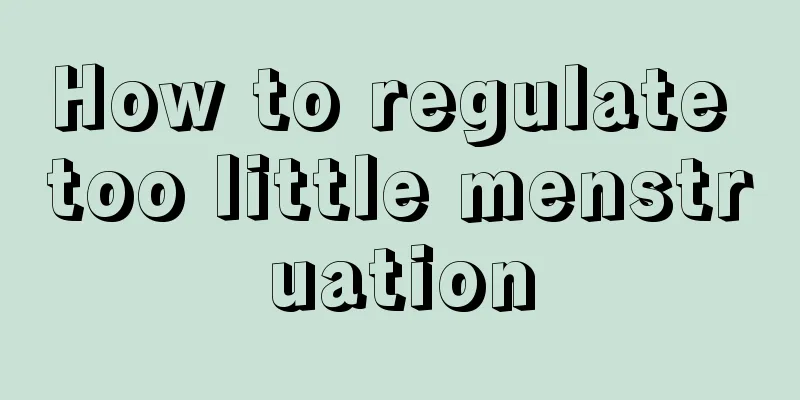How to regulate too little menstruation

|
Menstrual problems are problems that many female friends have nowadays, such as delayed menstruation, irregular menstruation, and small menstrual flow. We all know that the state of menstruation is related to the physical and mental health of female friends themselves. So, how to take care of light menstruation? This is a question that many women are very concerned about. In fact, when taking care of light menstruation, you must take care of it according to the actual type to get better results. How to take care of your period if it is too light 1. Cold blood type. Main symptoms: delayed menstrual cycle, scanty flow, dark color, blood clots, cold pain in the lower abdomen, pain relieved by heat, chills and cold limbs. The tongue is pale and dark in color, the tongue coating is white, and the pulse is deep and slow. Treatment method: Promote qi and blood circulation and regulate menstruation. Chinese medicine prescription: modified Shujing Decoction. 10 grams of cinnamon twig, 10 grams of mugwort leaves, 9 grams of cooked aconite, 15 grams of Chuanxiong, 12 grams of Qianghuo, 6 grams of raw licorice, 20 grams of Codonopsis pilosula, 15 grams of Atractylodes macrocephala and Poria cocos, and 12 grams of Achyranthes bidentata. Explanation of the prescription: This prescription uses cinnamon twig, mugwort leaf, and cooked aconite to promote qi and blood circulation and regulate menstruation, chuanxiong and notopterygium incense to nourish qi and blood, promote blood circulation and remove blood stasis and regulate menstruation, codonopsis, atractylodes, poria, and raw licorice to nourish blood and regulate menstruation, and Achyranthes bidentata to promote blood circulation, remove blood stasis and unclog the meridians. 2. Blood stasis type. Main symptoms: delayed menstrual cycle, more or less menstrual volume, longer or shorter menstrual duration, purple-black menstrual blood with blood clots, lower abdominal pain that refuses to be pressed, and pain is relieved after the blood clots are discharged. The tongue is dark purple with petechiae and ecchymosis, the tongue coating is white and greasy, and the pulse is thin and astringent or stringy and astringent. Treatment method: Promote blood circulation, remove blood stasis and regulate menstruation. Chinese herbal prescription, Taohong Siwu Decoction combined with Shixiao Powder. 12g Chuanxiong, 9g Qianghuo, 12g White Peony Root, 15g Rehmannia Glutinosa, 10g Peach Kernel, 6g Rose, 10g Stir-fried Pollen, 10g Fructus Aconiti Lateralis, and 30g Leonurus Grass Granules. Explanation of the prescription: This prescription uses Siwu Decoction to invigorate Qi, nourish blood, promote blood circulation, remove blood stasis and regulate menstruation. Peach kernel and rose flower promote blood circulation and remove blood stasis. Stir-fried Puhuang, Notopterygium wilfordii and Motherwort granules promote blood circulation, remove blood stasis and activate blood circulation. 3. Damp phlegm type. Main symptoms: delayed menstrual cycle, scanty stool, light red color, sticky and greasy like phlegm, obesity, chest tightness, shortness of breath, nausea, large amount of clear and thin stool, white color, sticky and greasy. The tongue is pale, fat and has teeth marks, the tongue coating is white and greasy, and the pulse is slippery. Treatment method: Relieve cough, resolve phlegm, eliminate dampness and regulate menstruation. Chinese medicine prescription: Cangfu Daotan Pills interaction. 15 grams of fennel, 6 grams of Poria, 20 grams of Coix seed, 10 grams of red peony root, 10 grams of Atractylodes macrocephala and Poria, 12 grams of Arisaema consanguineum, 12 grams of Cyperus rotundus, 12 grams of Citrus aurantium, 12 grams of Ligusticum chuanxiong, and 9 grams of Notopterygium wilfordii. Explanation of the prescription: How to use this prescription: Rhizoma Atractylodis Macrocephalae, Poria cocos and Coix seed can relieve cough, resolve phlegm and dampness, harmonize the stomach and strengthen the spleen, while Radix Paeoniae Rubra, Atractylodes macrocephala and Poria cocos can resolve dampness. The spleen and stomach, the Arisaema consanguineum can eliminate dampness, relieve cough and resolve phlegm, the Cyperus rotundus and the Fructus Aurantii Immaturus can promote qi and relieve stagnation, the Ligusticum chuanxiong and the Notopterygium invigorate blood circulation, remove blood stasis and regulate menstruation. |
<<: How to treat colds during menstruation
>>: Can I use Chinese medicine to soak my feet during my period?
Recommend
What to do if menopausal symptoms are severe
We cannot ignore the menopause in women. We must ...
The 10 things your body fears most after being infected with the new coronavirus. It’s best not to do any of them!
After being infected with the new coronavirus, th...
How do women maintain their uterus?
Only by caring about women's physical health ...
How to diagnose lung cancer? Doctor: There are three "magic weapons" to diagnose lung cancer
Today a colleague asked me, "Why are there s...
The weather is getting warmer! Do you often have an oily face when the seasons change? Here are some tips to help you solve the problem of oily face
Spring is a good time to travel as the temperatur...
The causes of bloating and hiccups Hiccups convey 7 disease signals
Hiccups are a common symptom that we encounter fr...
Women are prone to gynecological diseases because they are "spoiled"
In daily life, many women have been "torture...
Be careful when large pieces of teeth fall out! Why is it not as simple as dental implants?
July 23 is World Dry Day. Sjögren's syndrome ...
Are gynecological warts serious?
Many women suffer from genital warts, and some ev...
What to do if a blister grows on the vagina
The labia is the most private part of a woman, an...
Increasing 3 types of food and reducing 3 types of food at the same time is the basis for protecting blood vessels and protecting the heart!
A healthy diet is the basis for protecting blood ...
How to catch up with the decrease of breast milk
A decrease in breast milk is not a good thing for...
I can’t move my neck when I wake up. Is it the pillow’s fault for my stiff neck?
You may have had this experience: you were fine b...
What is whole wheat bread? When should whole wheat bread be eaten?
Whole-wheat foods are rich in vitamins, minerals,...









